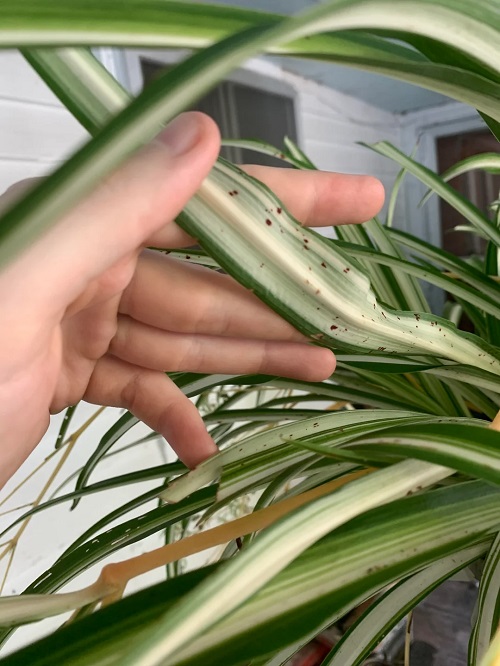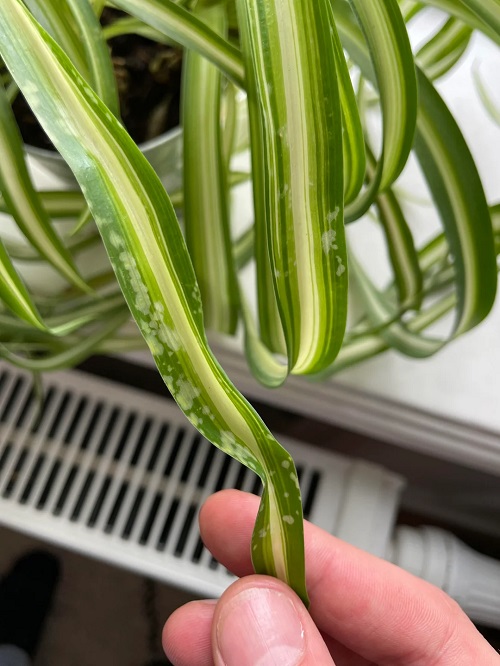Love those green fronds crowning your center table? Get the scoop on common Spider Plant Diseases and their Treatments so they keep thriving!
Ever seen your spider plant looking under the weather and wondered what’s wrong? Well, we have the answer! Discover the Common Spider Plant Diseases and the best solutions so they can happily dwell with you!
Here are the Best Types Of Variegated Spider Plants
Common Spider Plant Diseases and How to Treat Them
1. Leaf Spot Disease
Notice any weird spots on your spider plant? That’s a common spider plant disease that manifests as black, brown, or yellow spots along the leaf edges. Fungal leaf spots generally occur when fungi like Alternaria, Cercospora, Fusarium, and Phyllosticta invade the leaves through water-logged soil or excess moisture on the foliage.
Poor air circulation exacerbates the issue, as stagnant, humid air creates an ideal environment for these fungi to thrive and multiply.
How to Treat:
Trim affected leaves using clean scissors to prevent further spread of the disease. Don’t just follow a set standard for watering them; check the soil and water when it feels a bit dry to the touch. Also, avoid overcrowding it with other plants to allow enough air circulation around the space.
2. Gray Mold (Botrytis)

Gray Mold, or Botrytis, is another fungal disease that can wreak havoc on your spider plants. It appears as a fuzzy gray growth on the leaves, stems, and even flowers.
It thrives in conditions of high humidity and poor ventilation. One of the primary triggers for its development is prolonged moisture on the plant’s foliage. The spores land on wet plant surfaces and start to grow, feeding on the plant tissue. Overly damp conditions mostly accelerate its spread.
How to Treat:
Firstly, separate the infected plant from other healthy plants to prevent the spread of spores. Trim away the affected foliage and use a market-based natural fungicide to combat this condition. Ensure to follow the labelled precautions to avoid any mishap.
3. Southern Blight
Southern Blight is a soil-borne fungal disease caused by Sclerotium rolfsii. You’ll typically see a white, cottony fungus growing around the base of the plant, followed by wilting.
It is a common issue in warm, moist soil conditions, especially when the medium is compact without enough drainage.
How to Treat:
Repotting is the best bet in such a condition. Just ensure to use a well-draining medium this time, mixing in enough sand or grainy material so it doesn’t hold much moisture.
4. Rust Disease

Rust Disease is another problem that spider plant owners encounter. It manifests as rust-colored spots or pustules on the undersides of spider plant leaves. Over time, this can lead to yellow leaves and, ultimately, leaf drop.
The culprit behind rust disease is fungal spores, which are spread primarily through the air or water splash and require moisture to germinate. Overcrowding, poor air circulation, and high humidity levels are just the right trio for this disease.
How to Treat:
Provide enough space for the plants to breathe, and don’t forget to snip off the affected parts. Avoiding overwatering is non-negotiable.
5. Powdery Mildew

Got some white, powdery stuff on your plant? That’s Powdery Mildew, making itself at home that takes its first step in a damp, humid environment but spreads like fire in dry soil conditions.
When you accidentally expose your plant to this duo, the fungus lands on the leaf surface and begins to grow, forming a white, powdery coating on the foliage or on the soil surface.
How to Treat:
Powdery mildew might affect the soil as well, so it’s better to change the medium completely and mix a fistful of neem cake in the fresh potting mix.
6. Anthracnose

Anthracnose is a common fungal disease in plants caused by the fungi Colletotrichum that typically occurs when you leave the plant in damp conditions, either due to overwatering, poor drainage, or high humidity. They might also give you a surprise visit if you place the plants way too close, compromising the air circulation.
The common signs are dark, wet spots or mushy patches on the foliage.
How to Treat:
If the damage is not yet too much, trim the affected foliage and cut down on watering. Conversely, in case of extreme damage, take the plant out of the pot, cut out the damaged parts, and repot in a fresh potting mix.
7. Phytophthora Root and Stem Rot
Root rot is probably the most common issue caused by the fungi named Phytophthora. The first signs are wilting and yellowing of leaves and dark lesions on roots and stems.
Again, a result of overwatered soil conditions with poor drainage and lack of air circulation. The fungus attacks the plant’s roots and lower stem, cutting off its ability to absorb water and nutrients, further worsening the condition.
How to Treat:
Snip off the affected foliage and root portions. You can also divide it to multiply your collection. Then, use a fungicide in the new potting mix to rule out any chances of further infestation.







